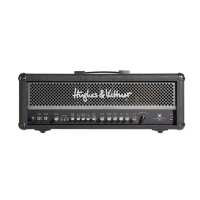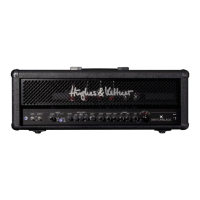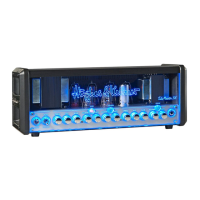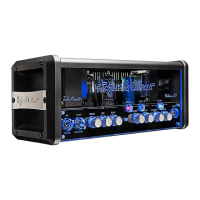10
S w i t c h b l a d e T S C
FACTORY SETTING: MIDI CHANNEL = 1, OMNI = ON
Note: OMNI ON is helpful if you are unsure via which channel a connected
MIDI device sends its messages.
During the MIDI setup routine, the LEDs that normally indicate the preamp
Channel indicate the MIDI Channel. The following table MIDI Channel lists the
MIDI Channel settings in what is called binary code:
MIDI-
Channel
Boost Clean Lead Ultra
1
2
3
4
5
6
7
8
9
10
11
12
13
14
15
16
Press and hold SERIAL for a few moments to quit the MIDI setup routine and
store the settings. The amp returns to its most recent operating status (normal
mode).
7.3 Factory Settings and Factory Reset
A factory reset is a seldom needed feature. Nevertheless, be sure to read the
explanation carefully to ensure you don’t accidentally delete your presets.
7.3.1 Triggering a Factory Reset
If you press STORE and FX SERIAL simultaneously while powering the amp, all
settings are reset, including the 128 MIDI-switchable presets and the basic MIDI
configuration.
7.3.2 Factory Presets and Basic MIDI Configuration
The SWITCHBLADE TSC is delivered ex-factory with 64 different presets
(memory slots 1-64). In the memory slots 65-125 you will find copies of the first
64 presets. You may find a list of all the presets on the accompanying sheet.
The basic MIDI configuration is:
• OMNI ON • MIDI Channel: 1
• FX ON is switched off • SERIAL is deactivated
Caution: This procedure is a last-resort option! It irrevocably wipes out all
stored settings.
7.4 Storing Settings/Programming
You have two options for storing a preset to one of the 128 memory slots: Select
a new memory slot via MIDI (7.4.1) or overwrite the preset directly at the device
(7.4.2).
7.4.1 Selecting a New Memory Slot via MIDI Learn
• Press the STORE button briefly; it lights up to signify that it is armed (MIDI
Learn).
• Select a MIDI bank from 1 to 32 on the FSM 432; it flashes to signify that the
FSM 432 is waiting for input via one of the four preset buttons A to D.
• Engage preset button A,B,C or D; the board stops flashing, the light on the
STORE button extinguishes, and the preset is stored.
Caution: When the FSM 432 is in DIRECT MODE (see chapter 7.1.2), a
BANK UP/DOWN command also triggers the storage process! We recommend
deactivating Direct Mode when programming to prevent inadvertent
overwriting of presets.
Note: Here’s how to proceed for other manufacturers’ MIDI boards and MIDI-
enables devices: Arm SWITCHBLADE TSC by engaging the STORE button
and selecting the desired memory slot. As soon as SWITCHBLADE TSC
receives a valid program change command, the STORE button extinguishes
and the preset is stored.
If an error occurs (the amp remains armed), you can cancel the storage process by
pressing STORE again.
7.4.2 Overwriting Presets Directly at the Device
There is an easier way to overwrite the most recently selected preset than going
from the amp to the MIDI board and back after every edit: Press and hold
the STORE button until its light extinguishes (after about two seconds). The
ORIGINAL VALUE and the Channel LEDs also flash to confirm. Then you can
release the STORE button and your settings are stored.
8 Replacing Tubes, Service and Preventive Maintenance
SWITCHBLADE TSC is factory-loaded with EL34 and 12AX7 tubes. Once
they’ve been burned in – that is, operated continuously under a load – they are
subjected to a rigorous selection process. Their electrical specs and mechanical
status (microphonics) are checked, and then they are installed in an amp and their
sonic performance is auditioned. One of the most important steps in this process
is tube matching, whereby tubes with the same characteristics are teamed up in
matched sets of power tubes.
When to Replace Tubes
The tubes in SWITCHBLADE TSC are exemplary in terms of quality, workman-
ship and long service life. What’s more, the TSC module ensures that even
well-worn power output tubes always run at the proper load, thus prolonging
service life and yielding the best possible sound. Nonetheless, tubes show definite
signs of wear when their service life is nearing its end. Telltale signs are increased
microphonics, noise and hiss, muddier tone through loss of high-end frequencies,
degraded performance, etc. Take these indications seriously and replace old tubes.
Not only do these side effects take their toll on sound quality, they also indicate
the aging tube will soon fail!
Note: We tweaked the amp and factory presets specifically for EL 34 tubes,
but thanks to TSC you can use one or several 6L6GC tubes. Read sections
5.3.2 and 5.3.3 to learn more. Trying out tubes other than these two types may
sound like fun, but we strongly recommend you refrain from experimenting.
Installing the wrong tubes will damage the amp and cost you a lot more than
you bargained for in repair costs.

